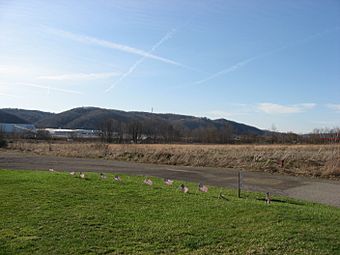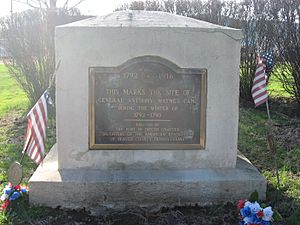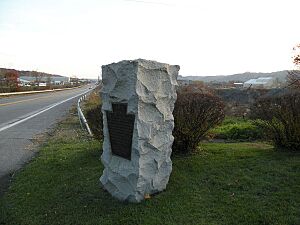Legionville facts for kids
|
Legionville
|
|

Overview of the site
|
|
| Nearest city | Harmony Township, Beaver County, Pennsylvania |
|---|---|
| Area | 20 acres (8.1 ha) |
| Built | 1792 |
| Architect | Legion of the United States |
| NRHP reference No. | 75001617 |
Quick facts for kids Significant dates |
|
| Added to NRHP | March 27, 1975 |
Legionville was the very first place where the U.S. military formally trained its soldiers. It was like a special school for new recruits. The camp was set up in the winter of 1792 by Major General Anthony Wayne. It was located near what is now Baden, Pennsylvania, which is a town close to Pittsburgh.
Soldiers trained here to become part of the Legion of the United States. This was a new army created to fight in the Northwest Indian War. This war was a conflict between the U.S. and Native American tribes who were part of the Western Confederacy.
Throughout the winter of 1792-93, both new and experienced soldiers practiced military skills. They learned tactics and how to follow orders. In the spring, the Legion of the United States left Legionville. They went to fight in the Northwest Indian War.
The training at Legionville was very important for the Legion's success. They won a big victory at the Battle of Fallen Timbers on August 20, 1794. Many people believed this victory was thanks to the excellent training the troops received at Legionville.
Contents
Why Legionville Was Needed
The U.S. military realized it needed a strong, well-trained army. This became clear after a big defeat on November 4, 1791. An army led by General Arthur St. Clair was almost completely defeated by the Western Confederacy. This happened near Fort Recovery, Ohio.
After this defeat, U.S. President George Washington and Secretary of War Henry Knox supported a plan. This plan was to create a new army called the Legion of the United States. Its structure was based on ideas from famous military leaders like Henry Bouquet and Maurice de Saxe.
In 1792, Anthony Wayne was asked to come out of retirement. He was a hero from the American Revolutionary War. He became the Commander-in-Chief of the Legion with the rank of Major General. The Legion was formed in Pittsburgh. It included soldiers from older units of the Continental Army. New recruits also joined to form additional groups within the Legion. From June to November 1792, the Legion stayed at Fort LaFayette in Pittsburgh.
Setting Up the Camp
By October 1792, Major General Wayne was looking for a good place to train his army during the winter. He wanted a spot far from the busy city. Wayne found the perfect location about 22 miles from Pittsburgh. It was on the eastern bank of the Ohio River, near where the town of Baden, Pennsylvania is today. This site might have been where an old Native American village called Logstown used to be.
On November 9, a small group arrived to start preparing the camp. On November 28, 1792, Wayne left Pittsburgh by boat. He arrived at the new camp, which he named Legion Ville.
The camp was designed with defenses in mind. It had steep hills on three sides. Four small forts, called redoubts, surrounded the camp. Each redoubt had 36 soldiers, and another 120 soldiers guarded the edges of the camp. A defensive ditch around the whole camp was more than a mile long. In total, 260 men guarded the camp all the time.
In less than a month, Legion Ville grew very quickly. It had more than 500 buildings. Its population was five times larger than Pittsburgh's at the time. Soldiers lived in single-story wooden barracks. Officers had two-story buildings. Major General Wayne's house and the hospital were two-story log cabins. The entire camp covered about 35 acres (140,000 m2). Around 2,500 people lived at Legion Ville.
Life and Training at Legionville
Once all the soldiers were settled, serious training began. The troops practiced shooting at targets every day. Wayne wanted them to be excellent marksmen. They also did bayonet drills and hand-to-hand combat. Mock battles and overnight trips outside the camp were common.
The cavalry, called dragoons, built an obstacle course. The artillery officers set up a special range for cannons. Another rifle range was built nearby. Soldiers marched constantly. New officers learned battle formations and tactics. Discipline was strict, and courts martial (military trials) happened often. Even small mistakes were punished. Captain William Eaton, who later led the U.S. Marines in Tripoli, often served as a judge.
During the winter, 16 private soldiers died at Legion Ville. They were buried in an unmarked cemetery inside the camp. Local archaeologists found the exact location in 2013 using a special dog. Some of the soldiers who died were Henry Dundalo, William Perry, James White, and John Fry.
An officer duel also happened, where Lieutenant Daniel Jenifer killed Ensign William Pitt Gassaway. The ensign was buried in the same unmarked cemetery. Colonel Thomas Proctor visited the camp and helped the artillery improve their skills. On February 26, 1793, a doctor named Joseph Strong drew a picture of the site. This drawing is the only known picture of the camp and is kept at Yale University.
In March 1793, Seneca leaders Guyasuta and Big Tree met with Wayne at Legion Ville. They discussed peace terms. However, the talks failed. President George Washington then approved the campaign against the Native American tribes.
On April 30, 1793, a large group of military boats left Legion Ville. They traveled down the Ohio River to Fort Washington in Cincinnati, Ohio. On August 20, 1794, the Legion of the United States defeated the Indian Confederacy at the Battle of Fallen Timbers. This victory led to the Treaty of Greenville being signed on August 3, 1795. This treaty opened up new lands for settlement.
The strict discipline and intense training at Legion Ville were very important. They helped the Legion achieve one of the most successful military campaigns in early U.S. history.
Legionville's Legacy Today
Over the years, the land where Legion Ville stood changed owners many times. In 1824, the Harmony Society bought the property. Later, it was owned by the A.M. Byers Ironworks Company, and then by National Tire and Rubber Company.
In 1973, a group called the Anthony Wayne Historical Society was formed. Their goal was to protect the site. In 1994, the name changed to the Legion Ville Historical Society.
A Republican senator from Pennsylvania, John Heinz, wanted to make the site a national park. However, President Jimmy Carter did not sign the bill into law due to a small mistake. National Tire and Rubber eventually sold the site. In 2005, developers bought it. In 2013, part of the site was even suggested as a place for a car dealership.





